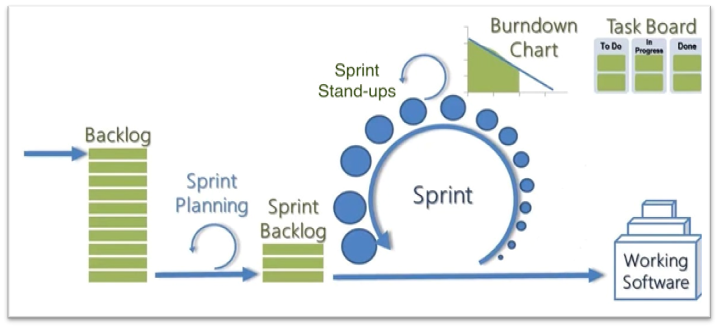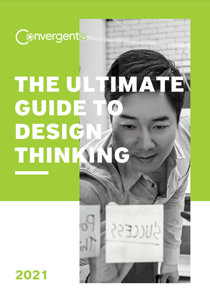Now, that you’ve been through the explore, discover and design phases of Design Thinking, we have now reached one of the most exciting, the deliver phase, where it all comes to life in a fully functional application. Loosely described, the deliver phase occurs when all the user insights and mockups are now turned into a working solution through software development and configuration.
From our experience, the key to the success of the Deliver phase starts even before the handoff occurs. In addition to involving our customers and end-users in every step, developers must also be engaged early. Consider that the very people who bring the solution to life should already be aware of the mockups that were iterated in the design phase. This ensures that the solution decided on by the customer is already technically feasible, and developers are ready to hit the ground running.
Including the development team in the beginning of the design thinking process is essential to the human-centered innovation approach. Through this approach developers gain insights into how users work and can help inform development decisions with a firsthand look into the customer’s current experiences. Design experts can prototype with an understanding of the technical restraints they are up against. With that in mind, what does the handoff from mockup to fully functioning solution look like in action?
How ConvergentIS Delivers
Digging deep in our interactive sessions in our Design Thinking workshops is essential to the delivery step, since it allows our team to dig into the problem itself rather than jump directly into the solution. Once enough information is collected, along with well-supported design documentation, we can create a built-out user story. Each user story is role-specific and outlines the features that need to be developed. For example, within the same application one user story might be that a manager needs to have the dashboard summarized by a team whereas the team member will just require an individual view.
A complete collection of all these role-based user stories along with the accompanying mockups defines the features of the application. After documenting these user stories and estimating the rough hours required for development, our team sits down with our teammates on the customer side to review the complete list of user stories and make sure all the core features (or Minimum Viable Product) can be completed within a reasonable timeframe.
Using the documented insights from our Design Thinking workshop, our Design team will provide developers with a clean version of the mockup that closely resembles what the end-user will see. They will also include notes (or design annotations) that outline the exact details and functional requirements that will be needed in each component of the solution. This format makes development run smoother as the team can visualize the requirements with greater accuracy, reducing re-work and decreasing development time.
An Intro to Agile Methodology
In alignment with design thinking principles, ConvergentIS leverages an agile methodology to ensure the quick iterations in prototyping carry through to user acceptance testing. The value of this methodology has been recognized by many, including the Founder and Executive Chairman of World Economic Forum, Klaus Schwab, who shares:
"In the new world, is it not the big fish which eat the small fish. It's the fast fish which eats the slow fish."
With an ever-changing environment, it is the agile companies that can develop creative solutions and push them live quickly that are succeeding. Therefore, along with the Design Thinking process, agile methodologies like sprint planning are essential to project success.
The term sprint describes a set period where specific tasks are completed towards a defined goal. In many cases, organizations have followed a similar two-week timeline for each work period. The delivery lead will look at the user stories which make up the product backlog and determine which are priorities for the current sprint. The leader will then look at the existing work the team has on their plate and allocate new tasks to the sprint backlog (the tasks that need to be completed in the current spring period) accordingly. Sprint planning occurs before the start of each period in a cycle (see figure below).

The duration of the delivery process is broken out into sprints, following a similar cycle each time. Delivery leads may reference a burndown chart, which is a graph showing the amount of work completed in each sprint and the percentage of tasks remaining. In project management software, items can be moved by the development team from "to do" to "in progress" and finally to "done," which will be reflected in the burndown chart.
Once, we have sign-off from the client, the user stories are categorized and placed in project management software like ADO or Jira. Once confirmed, we assign each user story to a two-week sprint along with the resource who oversees its completion.
As each task is completed, the development team will slowly gain a collection of user stories that are ready to be demoed. Rather than waiting until all stories are complete, we use similar cycles for user acceptance testing (UAT). Doing this testing in stages ensures that there are no surprises when the project draws to a close. The process referenced in figure 1 is nothing revolutionary and instead can be recognized as an industry best practice for agile software development.
Optimizing the Delivery Phase for Success
In practice this methodology is effective, especially when the implementation team embeds themselves into the company undergoing the transformation. The ConvergentIS team found that sharing tools such as Microsoft Teams channels, SharePoint, or ADO with our customers is essential in creating the foundation for us to gain a team dynamic accompanied with a shared outcome. Working side by side rather than across the table is a known method for increasing innovation and collaboration, that our team continues to abide by.
The result of these efforts has been commented on by many of our customers. One worth mentioning was from a project manager at a multi-national energy company who shares,
“Without a doubt, we picked the right implementation partner, we are really impressed with the quality of work and the low number of defects.”
This post on the delivery phase is the last in our Design Thinking in Practice series. Read the previous post about the Design phase here.
Have additional questions or wonder how these processes can help your business? Download our free guide.


